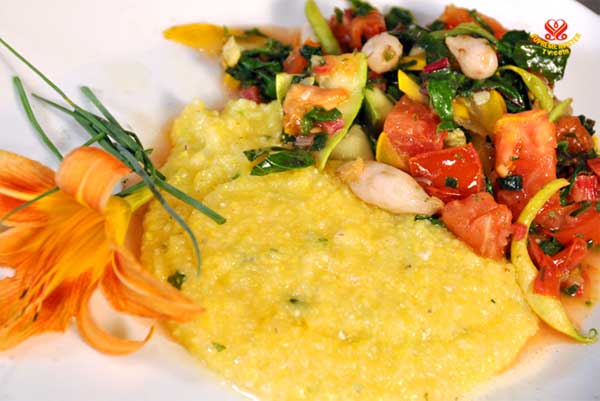(For all ingredients, please use organic versions if available) Polenta (Serves 8)5 cups soup stock or water, cold 2 cups polenta, medium coarse ¼ cup onion, diced 2 cloves garlic, minced ¼ cup olive oil 1 tablespoon salt Fresh ground pepper, 3 turns on the grinder Seasonal Vegetable and Fresh Herb Ragout (Serves 8)4 cups seasonal vegetables 4 cups diced fresh or canned tomatoes 1 cup onion, diced ¼ cup olive oil 4 cloves of garlic, minced or whole cloves ½ cup mixed fresh herbs, chopped 1 tablespoon salt Fresh ground pepper, 3 turns on the grinder 
- Heat the pan for a while, pour in the olive oil, add in the minced garlic and the diced green onion into the pan.
- Add in a tablespoon of salt, a pinch of black pepper, and sautéeverything for about 1 minute or so.
- Deglaze with the water or soup stock.
- Make sure not to burn the garlic.
- Turn the flame off, and clear out the pan with one and a half quart of water or soup stock.
- Turn the heat into high, and let the water boil.
- At the same time, put in the polenta. Start when the water is still cold, so the grains don’t stick together.
- Stir the polenta every 30 seconds or so to make sure it’s not sticking together or balling up, so that it has a nice smooth consistency.
- To start preparing the ragout, use some locally grown yellow squash or other squash, an Italian zucchini, Jerusalem artichokes, green onion, Swiss chard, and green beans.
- Pre-heat the olive oil, add in the garlic green, the stem of the Swiss chard (keep the leaf separate), green beans.
- Add in a bit of salt, add in the Jerusalem arcichokes.
- Add in a little bit of white pepper, a little bit of fresh ground black pepper, and then maybe another tablespoon of sea salt.
- Cook it at a low temperature.
- Add in the squash pieces. Let it cooked for a while.
- Add in the Swiss chard leaves.
- Add in the herbs: the basil, the rosemary, the sage, and the savory.
- Add in the tomatoes. Mix it.
- The ragout is ready.
- There are two different ways of preparing the polenta. First, add some olive oil on a pan, then take some of the prepared polenta and put it on a pan. Make sure to save some polenta for the other version of preparation which is going to be plated up as porridge.
- Let the polenta sit on the pan or put it in the refrigerator for faster cooling.
- When the polenta cooled, cut the polenta down kind of like tempeh or some sort of cake.
- It basically becomes almost like its own loaf and it firms up and you cut that and you can bake it in the oven.
- The other version of preparation is to plate the polenta as porridge.
- Place the ragout nicely and decorate it with chives and other nice color vegetables, sprinkle a little bit of black pepper, and drizzle a little bit of olive oil.
- Ready to be served.
|